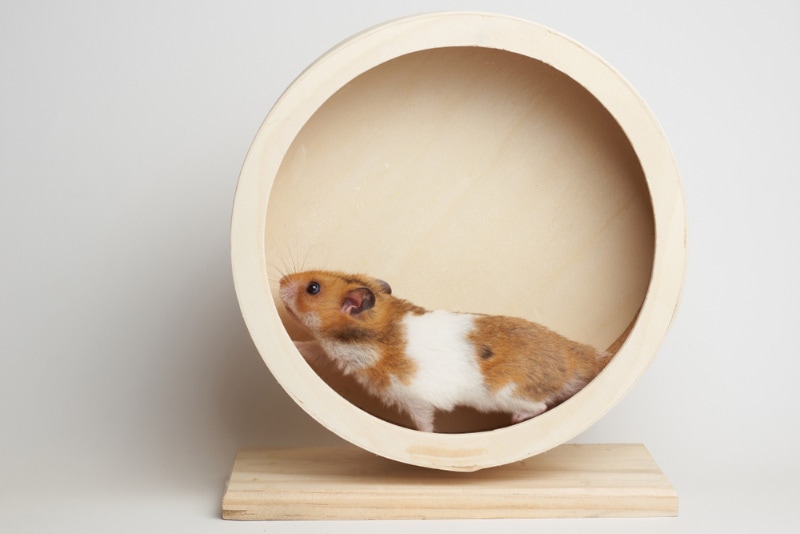6 DIY Hamster Wheels You Can Build Today (With Pictures)

Updated on

Hamsters are fun, cute little pets that are relatively easy to care for. For the most part, they’re also quiet little creatures, apart from the occasional sound of scratching against the plastic tray of their cage and potentially the incessant squeaking and knocking of the hamster wheel. Although they don’t need walking like dogs, hamsters do need regular exercise. You can provide access to a hamster ball that also allows your little one to explore the house, or you can have a hamster-safe area where it can run around securely and safely. Alternatively, or additionally, you can provide a hamster wheel in the cage.
Below are DIY hamster wheels you can build today, using a variety of household items and readily available materials.

The 6 DIY Hamster Wheels
1. Very Silent Homemade Hamster Wheel Using an Old Hard Disk Drive by Instructables

| Materials: | Hard Disk Drive, Metal Coffee Can, Glue, Zip Ties |
| Tools: | Torx Screwdriver, Metal Scissors |
| Difficulty: | Moderate |
This silent homemade hamster wheel solves two problems that some hamster owners might share. It offers a viable use for an old hard disk drive, and it makes a silent hamster wheel. The plans teach you how to get into the hard drive and it also gives you tips on how to connect the hard drive’s spindle to something like a speedometer. The spinning of the wheel creates a small amount of current which can then be used to power the speedometer and you can see how quickly your little furry friend is running.
Other than the hard drive, you will need a metal coffee can to act as the actual wheel section of the design. Other materials include zip ties and hot glue.
2. Make a Hamster Wheel Easily from Cardboard by Mr. H2
| Materials: | Cardboard, Straw, Craft Lollipop Sticks |
| Tools: | Compass, Pencil, Ruler, Craft Knife, Drill |
| Difficulty: | Easy |
This hamster wheel uses inexpensive craft materials including lollipop sticks and cardboard, as well as a straw. It does look a little rickety when finished so it likely won’t last years, but it costs so little and takes so little time to make, you can always make another when it breaks. Alternatively, you could add some cross beams between the two leg sections to add some further stability. But the lightweight design means it runs smoothly and your hamster can get some real speed.
3. DIY Silent Hamster Wheel Using Skateboard Bearings by Instructables

| Materials: | Skateboard Bearings, Bolt, Nut, Washers, Wood, Hamster Wheel |
| Tools: | Drill, Pliers, Hot Gun |
| Difficulty: | Moderate |
This isn’t a plan to make a hamster wheel from scratch, but it is a plan to help resolve the problem of a squeaking, rattling, groaning hamster wheel you already have. The DIY silent hamster wheel uses skateboard bearings to ensure a smooth rotation and to eliminate most of the noise that comes from traditional hamster wheels.
4. DIY Hamster Wheel by SomethingAnimal
| Materials: | Wood, Bolt, Nuts, Screws, Circular Container |
| Tools: | Drill |
| Difficulty: | Easy |
This DIY hamster wheel is made completely from scratch and uses a circular container as the wheel section of the design. You can use a plastic tub container but if your hamster is a known chewer, you should look for a metal tin container instead. You should make sure the container is large enough to comfortably hold your Hamster, so typically an 8-inch tub, although you might need a 12-inch tub for larger species. The only tool you need is a drill, and the wheel can be made by anybody, regardless of their DIY expertise.
5. DIY Bucket Wheel by Curtis Lasane
| Materials: | Cake Container, Clothesline Pulley, Screws, Nuts, Bolt Screw, Wing Nut, Washers, PVC Pipe, Pipe Elbows |
| Tools: | Drill, Saw |
| Difficulty: | Moderate |
This DIY bucket wheel uses a plastic cake container and a selection of PVC pipes and elbows to create a bucket wheel. The wheel can be tightened or loosened according to how easily you want your hamster to be able to run in the wheel and the PVC plastic frame does a good job of keeping the whole wheel stable and secure.
6. DIY Hamster Ball Wheel by PetDIYs

| Materials: | Hamster Ball, Metal Rod, Nuts |
| Tools: | Drill |
| Difficulty: | Easy |
If you have a hamster ball that you no longer use or that you want to replace with a hamster wheel, and your hamster cage can be drilled through easily, you can turn the ball into a hamster wheel. Simply use a metal rod to hold the wheel in place and a drill to make the fixings. This hamster ball wheel project is easy, but it is dependent on you having a plastic hamster cage and an old hamster ball.

Do Hamsters Need a Wheel?
Hamsters need exercise to stay fit and healthy. You can put your hamster in an exercise ball or provide a secure, safe area where your hamster can run around, but putting a hamster wheel in the cage means that your hamster can run whenever it wants to. So, while it might be possible to provide the required exercise without one, having a hamster wheel will enrich your hamster’s life and make yours a little easier.
How Long Do Hamsters Use Their Wheel?
If you’ve ever owned a hamster and hamster wheel, you will know that they really enjoy running. In fact, some hamsters cover up to 5 miles a night on their wheel, and they will be running for several hours to achieve this kind of distance.

Is It Okay to Remove a Hamster Wheel at Night?
While a noisy hamster wheel is the last thing you want to hear when you’re trying to get to sleep, you should try not to remove the wheel at night. Hamsters are nocturnal. If you remove the wheel at night, your hamster won’t exercise because the wheel will only be accessible when they are asleep. Try to reduce the noise coming from the wheel or move the cage and wheel to a different room so it doesn’t interrupt your sleep but enables you to keep the wheel in at nighttime.
Why Does My Hamster’s Wheel Make So Much Noise?
Hamster wheels are notorious for squeaking, rattling, and making a cacophony of noises. Most wheels are made from plastic and metal, and they are either fixed to the bars of a cage or come with a free-standing stand. Noise can usually be attributed to the plastic of the wheel rubbing against the metal stand or the wheel itself tapping against the cage. Ensure the placement of the wheel is away from other items. Your hamster may also be creating some noise, for example by dropping seeds and other items in the wheel, or even by pooping in the wheel.

Conclusion
Hamsters need exercise and they can run as much as 5 miles in a single night when given a wheel. Above are plans for 6 DIY hamster wheels, with some innovative designs that use items like hard disk drives or skateboard bearings to create silent but effective exercise wheels. Determine what items you have that you can use in your hamster wheel design and then consider buying additional, inexpensive items like wood or plastic pipes and plastic containers.
Featured Image Credit: Johannes Menge, Shutterstock









